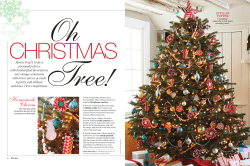
Renaxxance User Guide 1_ 5
EPIC NYLON-STRING GUITAR Thank-you for your purchase of Indiginus Renaxxance nylon-string guitar sample library! Renaxxance gives you amazing playability, with several articulations (ornaments), autovibrato, auto-harmony, and more. There are 3 tabs to choose 3 different panels: Main Panel Chords Panel Effects Panel Main Panel 1 7 2 3 4 5 6 1 The Ornaments panel gives you control over how key velocity and key-switches trigger the different articulations, or ornaments as we call them here. More on this later. 2 Vib Depth controls the depth of the Auto-Vibrato. 3 VIB, or Vibrato, turns the Auto Vibrato feature on. This is great for when you need to use your left hand for things like key-switches, scratching your nose, or giving your client a big “thumbs up!”. Or, maybe you just don’t have a mod wheel on your keyboard. 4 HARM activates the automatic harmony. You choose the interval and the key over on the Ornaments Panel. There is also a key-switch for harmony. Use this button when you want the harmony to stay on all the time. 5 12-STR gives you a 12-string guitar simulation. 6 CHORDS turns the first octave, from C1 to B1, into chord strums. You can choose between major and minor strums, and control the speed of the strums. Click on the “Chords” tab at the bottom to see the controls. 7 BODY RES adds an IR body resonance. The Ornaments Panel At the top of the Ornaments Panel you can select Velocity, Keyswitches, or Volume. Below we’ve selected Velocity. Slide to determine lowest key velocity that will trigger the ornament that you have selected. Choose the high velocity ornament here. Use the arrows or click and drag up on the name. As you play, the velocity will be shown between the sliders. Choose the low velocity ornaments here. Slide to determine the highest key velocity that will trigger the ornament you’ve chosen. Using Key Velocity to trigger ornaments. The way the panel is set above, Mutes will play when you play softly, at or below a key velocity of 44. Hammer-ons will be triggered when you play harder, with a key velocity of 97 or more. Normal sustained notes will play in the velocities in between. You choose the ornaments using the arrows on the left, or by clicking and dragging up on the name. This gives you complete control, and allows you to quickly set up for your playing style. Using Key Switches to trigger ornaments. Select Keyswitches to view controls. Here you can set the key-switches in the octave C0- B0. Key-switches override the velocity controlled ornaments. On other words, if you have the velocity settings like above, where Hammer-ons play at high key velocities, playing an A 0 (the Slide Up key switch) will override this, and you’ll hear an up-slide, no matter what the key velocity. The exception is the Harmony key switch, which will just add harmony to whatever ornaments are trigger by velocity. The key-switches are momentary, so as soon as you release a key-switch playing returns to normal. Ornament volume controls. Select Volume to view controls. If you are using velocity to control ornaments, you may need to turn them up or down in volume on occasion. Something to keep in mindHammer-ons and Pull-offs are sample groups that are used in several of the ornaments, including Hammer-ons, up and down Mordents, and Legato. Changing these will effect all of them. There is no separate Pull-off ornament, since this effect can be done using Legato. More Ornament Controls Key sets the master key for Hammer-ons, Mordents, and auto Harmony. You can choose from the Major keys, with their relative, Natural Minor scales, or from Harmonic Minor scales. If you are playing a Mediterranean or Middle Eastern style, you will probably want to choose the Harmonic Minor. The Hammer-ons and Mordents both have selections for Time and Scale/Semitone. Click and drag (up or down) on the note to change the timing. Choose Scale if you want these ornaments to stay in the scale of the master key, or choose Semitone if you would like half-step intervals always. Harmony. A drop down menu lets you choose the interval for the auto-harmony. Release Vol controls the volume of the releases, or the sound of the finger leaving the string. Finger Noise controls the volume of the background finger noises. RR Alt Time Renaxxance automatically alternates between down strikes and up strikes with each note played. The arrow, just to the right of the slider, shows you what is happening as you play. The RR Alt Time slider lets you adjust the amount of time that must pass before 2 down strikes are played consecutively. All the way to the left, and you’ll always get down strikes. All the way to the right, and the RR waits 3 seconds before resetting, so normal use you’ll always get alternating strikes. About the Ornaments Ornaments are articulations. The term is often used by classical guitar players. Hammer-ons are notes that are played by depressing a finger on a string that is already sounding, that is, without picking the string again. There are probably several ways of implementing HammerOns in a sample library, and we’ve chosen a method that seems to make sense for using them while playing a picking pattern. Let’s say you want to have a D note play and a Hammer-On to the E above. You would play the ‘E’ target note, just like if you were using the Up Slides ornament. Depending on the key you’ve selected, you will hear a D, then the E hammer-on. Mordents are like quick, single trills. You can choose ‘upper’ mordent or a ‘lower’ mordent, depending on whether you want the trill to go up or down. As with Hammer-ons, Mordents can follow the key that you’ve selected, or you can set them to always be a semitone. The timing is also adjustable. Slide Up is a sampled slide from a note 2 frets below to the target note. You can also perform a more subtle slide with Legato at low key velocities. Slide Down is a short, sampled slide down from the trigger note. The trick is to hit the next, lower note quickly to create the illusion of sliding from the high note down to the low note. You can be a bit more subtle if you use Legato at low key velocities. Mutes are short notes, played by plucking the string while the player’s palm is resting lightly on the string. Legato Legato is triggered by key-switch. You can choose the key-switch by selecting the “Keyswitches” menu at the top of the Ornaments Panel. Legato is monophonic, and lets you move from one note to another smoothly. Low key velocities slide between notes, while higher velocities create a Hammer-on or Pull-off effect, Chords Why does this button exist? What’s the point? This feature was almost left out, because I didn’t have a good answer. And yet, it’s kinda fun, so sometimes you just have to go for it! When this button is on, there are major or minor strums in the first octave, from C1 to B1. Clicking on the “Chords” tab brings up the controls: Just choose whether you’d like a major or minor strum on each key in that octave. Strum Speed controls the time it takes for the strum to occur. Vel to Strum Speed All the way to the left, and the strums are always the same speed, no matter the key velocity. Move to the right to make the strums play faster as you strike the keys harder. Alt Time Same idea as RR Alt Time, only this time concerning up and down strums. Release Volume On key release you’ll hear a muted strum. All the way to the left is off. Effects Click on the Effects tab to see the controls. Reverb Send and Size controls. Delay Send and Delay Time controls. Compressor Simultaneously adjusts threshold, ratio, and output for a painless user experience. If you need more controls, there’s always the Wrench! Extra Instruments You’ll find some additional instruments in this folder! RenaChords has major and minor chord strums, with the down strums in the first octave and up strums in the second octave. Chose Major or Minor for each scale step. Harmonic Dance makes an echo effect, with the ability to control the pitch of each echo. There are 2 echo generators. Each echo generator has a table graphic, where you can drag the pitch of each “echo” to one of 8 scale steps, which are dependent on the key you’ve chosen. The scale steps are zero-based, so the original pitch is 0, and one octave above is 7. You can turn each echo generator on or off. Key determines the scale that will be used. Time determines the speed, according to the master or host tempo. Echoes sets the number of echoes that will be played. Fade The higher this setting, the quicker the echoes die out. RenaDrum Simple percussion effect created by slapping the guitar with my hands. No guitars were harmed in the production of Renaxxance. All samples and materials © 2015 A. Tracy Collins DBA Indiginus
© Copyright 2025










